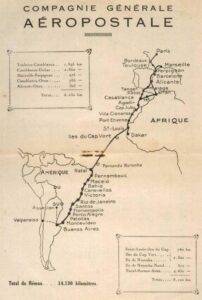
The Compagnie Genérale D’Entreprises Aéronautiques (Latécoére Lines) arrived in Argentina with the purpose of joining it with France. By the end of 1918, the route between Toulouse and Barcelona, Spain, had already been opened to the public. In September of the following year he extended it to Rabat and, ninety days later, to Casablanca.
Captain Joseph Roig, with pilots Etienne Lafay, Víctor Hamm and Paul Vachet, flew three Bréguet XIVs with an H2 Renault 300 engine, between Rio de Janeiro and Buenos Aires (El Palomar), via Montevideo. Then they went back on the road and arrived in Natal. The great challenge of French aeronautics was to open up to the world, after the terrible First World War, and make use of military flight equipment and all the personnel employed around it (mechanics, pilots, constructors, etc.).
El capitán Joseph Roig
con los pilotos Etienne Lafay, Víctor Hamm y Paul Vachet
The Casablanca terminal was moved to Dakar, the extreme point that could be reached within French West Africa. Shortly after, on February 8, 1927, Vicente Almandos Almonacid was appointed as the company’s representative in our country. It wasn’t just anyone. Born in Anguinán, La Rioja, the son of a businessman of the same name, he had emigrated to Buenos Aires after the economic crisis of 1890 and the death of his father a year later. In 1912 he traveled to Paris, where he specialized in piloting airplanes and participated in the First World War defending France. With his signature, on June 10, 1927 an agreement was approved with the General Directorate of Post and Telegraph to transport mail to Europe. Months later, adding the approval of the Civil Aeronautics Directorate, dependent on the Ministry of War, Lineas Latécoére began its experimental services from the General Pacheco airfield, north of Greater Buenos Aires, to Natal, northeast of Brazil. They were almost 4,700 kilometers with several stopovers: Montevideo, Porto Alegre, Florianópolis, Rio de Janeiro, Vittoria, Caravella, Bahia and Maceió. Aboard a Late 25-Renault 450 HP, Henri Rozes was the pilot of the baptism flight, accompanied by administrator Julien Pranville.
In 1927, at the initiative of Almandos Almonacid, the South American line was extended and the subsidiary was formed under the name Aeroposta Argentina S.A. It was assigned a capital of five million pesos and a board of directors headed by Marcel Boilloux Lafont, seconded by José Frías, Agustín Meilian, Em-manuel de Sieyés, Gastón Fourvell Rigolleau (industrialist known for his glassware from Berazategui, Bs. As.) , Guillermo Padilla, Alberto Dodero (famous shipping company), Luis Nicol, Alejandro Menéndez Behety (deep-rooted family of ranchers and merchants in Patagonia), José Oderigo and Manuel Pórtela Ramírez, as well as the brave Riojan.
On the first day of March 1928 the complete line was inaugurated. Even Fernando de Noronha went by airplane. The crossing of the Atlantic Ocean was still made in six ships of eight hundred to one thousand tons and 6,000 HP of power, leased to the French Ministry of the Navy. Thus it was arrived at Porto Praia, in the Cape Verde Islands. From there the plane was taken again to Toulouse, but first descending at Dakar, St. Louis, Port Étienne, Villa Cisneros, Cabo Juby, Agadir, Casablanca, Rabat, Tangier, Malaga, Alicante, Barcelona and Perpignan. This tour was done once a week, both ways, and took seven and a half days.

Aeroposta used the General Pacheco airfield, built by Latécoére, which had very good hangars, workshops, warehouses, offices, waiting rooms, garages, etc. Among the most prominent pilots are the famous writer of The Prince, Antoine de Saint Exupery, Henri Guillaumet, Jean Mermoz, Pedro Artigau, Pedro Ficarelli, Rufino Luro Cambaceres, Leonardo Selvetti, and the aforementioned Vachet, Rozes and Etienne.
In August, the company took the name Compagnie Genérale Aéropostale, which lasted until 1933 when it turned to Air France. In 1930 he made the first complete transatlantic mail, which would only be fully airborne on January 5, 1936.
On February 27, 1929, it was authorized to establish an agreement to transport correspondence “By Air” within the Argentine Republic and neighboring countries. For this reason, it opened four routes, which we detail due to their importance for communications and transportation in the country. We take these data and other information for this note from the great book Crónica Histórica de la Aeronáutica Argentina, by the journalist Antonio Biedma.

From the first day from 1929 to April 17, 1931, the aircraft covered, twice a week, Buenos Aires-Monte Caseros-Asunción del Paraguay (Suman Ánuguaian since the last day of winter of 1930). Since July 15, 1929 until June 21, 1931 he flew a weekly service between Buenos Aires-Mendoza-Santiago de Chile, which combined with the flight that came from France to General Pacheco. In the summer season between 1929 and 1930, daily services were circulated between Buenos Aires and Mar del Plata. From the first day of November 1929 until June 28, 1931, he assured trips between Bahía Blanca and Río Gallegos, initially with scale in San Antonio West, Trelew and Comodoro Rivadavia; On April 2, 1930, he was prolonged until the capital of Santa Cruz with stops at Puerto Desires-do, San Julián and Puerto Santa Cruz.
¿Qué aviones utilizaban?
Pues los fieles monoplanos Latécoére 25 y 26-Renault 450 HP citados anteriormente. Los 25 estaban diseñados para correo y cuatro pasajeros. Los 26 solo eran postales. En 1931 sumaron los 28 con motores Hispano Suiza de 500 HP, que duplicaban la cantidad de pasajeros. Para cruzar los Andes se empleaba un Potez 25-Lorraine 450 HP.
Las estadísticas indican que entre Buenos Aires y la capital paraguaya, por ejemplo, llegaron a transportar 877 pasajeros, 3.319 kilos de correspondencia y 4.814 de aeropaquetes. Para el tramo Bahía Blanca-Río Gallegos sumaron 940 pasajeros, 4.672 kilos de correspondencia y 6.586 kilos de aeropaquetes.


